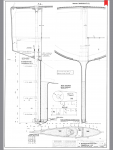geem
Well-known member
Where did I issue a chilling warning? I suggested you read the article which you have now done. The main point of their article was that spade rudders are maintenance intensive. There is a lot of load on a rudder that isnt supported at both endsThe article extols the virtue of carbon construction which many production companies have embraced by making the process cost effective. It also points to the need of expensive self-aligning bearings to accommodate large rudders - true - and the need to regularly maintain them, also true, the maintenance point being relevant to all.
Incidentally, why do you keep issuing chilling warnings like, "Read Morning Clouds assessment of rudder failure on their boat and why they no longer ocean cruise with a spade rudder."?
Where does it say that in your attached article, which opens:
"Despite the fact that I had up until that time owned three yachts that had spade rudders, had covered tens of thousands of miles aboard them, and but for a bad case of metal fatigue might never have had a concern about their use, my immediate reaction was to rule out having one on our next boat."But I learned a lot at the time as we fabricated a new rudder from scratch; not least in terms of how difficult—and expensive—it can be to do it right.
Before going on to conclude:
"Whilst I still prefer the strength and security that a skeg offers, I accept that a properly designed and constructed spade rudder can be a viable choice, but it must have some form of protection ahead of it in the form of a keel or prop skeg to reduce the risk of collision damage. One of the reasons I am not a fan of twin rudders is that this is virtually impossible to achieve with this configuration. "Which as I mentioned above is exactly the direction Hallberg Rassy is going, but that's another story !!





